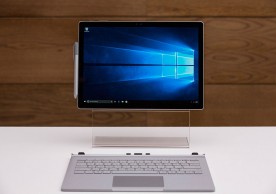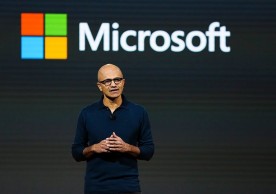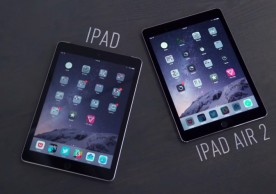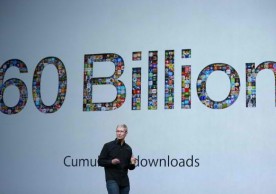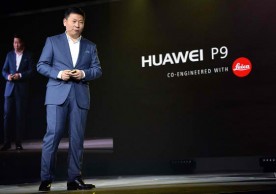It will soon be time to bid adieu to 2012 and welcome 2013 as Old Father Time comes knocking again. The tech market saw several new devices making a mark for themselves in the hotly-contested tablet space, but which one stood out from the crowd?
We take a look at the top five tablets of 2012, gadgets with innovation at their heart, which redefined how we perceive mobile devices.
1. Google Nexus 7
Google forayed into the 7-inch tablet market with its first tablet in the Nexus family, in partnership with ASUS, the Google Nexus 7, which was announced in June 2012.
The Nexus 7 with its 7-inch HD IPS display became an instant hit and the 16GB version sold out quickly, forcing Google to stop taking new orders. Google initially launched the tablet in 8GB and 16GB variants with Android 4.1 Jelly Bean. However, a revamped version of the Nexus 7 along with a new 32GB model was launched in November this year with Android 4.2 Jelly Bean on board.
One of the few complaints consumers have regarding the Nexus 7, is that it lacks a rear-facing camera and there is no microSD card slot, which means no expandable memory option.
Google recently announced that it would discontinue the 8GB model and consequently, dropped the price of the 16GB version from $249 to $199. The 32GB version of the Nexus 7 is priced at $249 (Wi-Fi) and $299 (Wi-Fi and HSPA+), making it one of the best budget tablets currently available.
2. iPad mini
Amidst speculations of will it or won't it, Apple launched the much rumored smaller sibling of the iPad, the iPad mini in Oct. 2012. With the launch of the 7.9-inch tablet, Apple too hopped on to the smaller tablet bandwagon.
The iPad mini, when compared to competing offerings, is not exactly inexpensive. However, with Apple's Midas touch writ all over the tablet, it comes as no surprise that the tablet has met with an overwhelming response.
The pre-orders for the tablet were sold out within minutes and the 16GB versions of the iPad mini priced at $329 sold out within 35 hours of its release.
With analysts predicting that the iPad mini's sales will touch 12 million by 2012 end, Apple's small wonder seems destined for big things.
The slight downer to the iPad mini is that it does not have a Retina display unlike its bigger sibling. However, with Apple said to be working on a iPad mini 2 with Retina display, consumers would soon have more to look forward to.
3. iPad 4
In a move that shocked and baffled many, Apple launched a fourth-generation version of its iPad in Oct. 2012, the same time as its iPad mini. The launch of the iPad 4 (called iPad with Retina display) came as a surprise especially since the company had launched the iPad 3 (called the new iPad) just seven months earlier in March.
The move was seen as a departure from Apple's policy of launching products only once a year. However, the iPad 4 continued Apple's success story and met with an overwhelming response. Apple did not change much with the iPad 4, with the notable exception of the faster A6X processor, which is two times faster than its predecessor. Another change was the introduction of the smaller 8-pin Lightning dock connector, which replaced the older 30-pin one. Apple also bumped up the front-facing camera to 1.2 megapixels from the iPad 3's 0.3-megapixel one.
In November, Apple announced that it has sold a whopping three million units of the iPad 4 and iPad mini in just three days.
"Customers around the world love the new iPad mini and fourth generation iPad," said Tim Cook, Apple's CEO. Cook further added "We set a new launch weekend record and practically sold out of iPad minis. We're working hard to build more quickly to meet the incredible demand."
The iPad 4 continues the Apple legacy and reinstates why the Cupertino-based company is a class apart and remains the tablet market leader.
4. ASUS Transformer Pad Infinity TF700
ASUS initially announced its Transformer Pad Infinity as the Transformer Prime TF700T at the CES 2012 event in January. The tablet was later renamed Transformer Pad Infinity TF700 at the MWC 2012 and released in the U.S, in mid-July. The 10.1-inch Transformer Pad Infinity TF700 improved on the original Prime in many ways.
The Infinity resembles many other convertible tablets from ASUS and is compatible with the Transformer Dock that is sold along with the device. However, with this tablet, ASUS bumped up the specs when compared to the Prime. ASUS also bumped up the processor speed to 1.6GHz for the Infinity TF700 (from Transformer Prime's 1.3GHz).
The Infinity TF700 with its 10.1-inch Super IPS+ display (1900 x 1200 pixels resolution) also has a higher pixel density than the MacBook Pro i.e. 224ppi versus 220ppi. However, the USP of the Transformer Pad Infinity TF700 tablet is the add-on keyboard docks, which at $149 may not be cheap but enhance the overall user experience of the Android-powered tablet. Thanks to its robust design and powerful processor, the ASUS Transformer Pad Infinity TF700 tablet is a winner, the $499 (32GB) price for the entry level model notwithstanding.
5. Nexus 10
Google expanded its Nexus line-up of devices in 2012 and launched a Samsung-made 10-inch tablet, the Nexus 10, in Nov. 2012. The Nexus 10 tablet met with overwhelming demand on the day of its release and was sold out quickly.
"There's been so much interest for the Nexus lineup that we've sold out of some of our initial stock in a few countries," Google said in a post on Google+. "We are working hard to add more Nexus devices to Google Play in the coming weeks to keep up with the high demand."
The Nexus 10 boasts an impressive 10.05-inch WQXGA display with 2560 x 1600 pixels resolution, and Google claims it is "highest resolution tablet on the planet." The tablet has a pixel density of 300ppi which wallops the 264ppi of one of the best tablets around - Apple's iconic iPad. The Nexus 10 has nearly one million more pixels than the iPad, which in turn has over one million more pixels than your standard 1080p TV!
Another notable feature of the tablet is the ARM Cortex-A15 dual-core chip, as most other tablets run on Cortex-A9 architecture.
The Nexus 10 is available in 16/32GB variants for $399/$499 and boasts a 5-megapixel rear-facing camera and a 1.9 megapixel front-facing snapper. Considering that the tablet is still sold out on the Google Play Store, it seems that Google has struck gold with the device. Garnering so much popularity in such a short span makes the Nexus 10 a strong contender for the top five tablets of 2012.
Two other notable tablets which nearly made it to the top five were the Samsung Galaxy Note 10.1 and Microsoft Surface, but the former lost out due its relatively low resolution, especially given the price it commands. As for Microsoft Surface, once it gains more support from developers, the Windows RT tablets will become a force to be reckoned with.
most read
more stories from Tablet
-
Google Earth Lets Users Explore & Enjoy The Planet With New & Improved Features
Google is giving Google Earth a new look and features that will let the users enjoy the planet in a whole new way.
ernest hamilton -
Microsoft Surface Pro 5 & Surface Phone Highly Unlikely To Launch At Microsoft's Upcoming Event; Here's What's More Likely To Make An Appearance Instead [VIDEO]
Amidst the lack of an official announcement regarding the product Microsoft will be unveiling at its big spring event on May 2, there's hearsay that the Surface Pro 5 and the Surface Phone will not make an appearance despite multiple rumors hinting at the devices' looming launch.
ernest hamilton -
Live Images of the HTC U Ocean Leak: It's Ready To Save The Subpar Ultra U
HTC is regrouping to deliver a better unit to redeem its predecessor's shortcomings.
ernest hamilton -
Microsoft Surface Pro 5 Latest News: Hardware Launch Event Confirmed In May; No New Laptop Reveal Expected
The May hardware launch event has already been confirmed, however, analysts say it is possible that no new laptop will be revealed during the said event.
ernest hamilton -
Breaking Down Microsoft's May 2 Event: Why The Surface Pro 5 Does Not Matter
May 2 might not be the perfect time for a new Surface Pro device.
-
Apple iPad Air 2 To Oust The Aged iPad 4? See Details [VIDEO]
As Apple runs out of stock of the iPad 4, it will be replacing the device that consumers bring in for service with the newfangled iPad Air 2.
ernest hamilton -
iPad Pro Mini Latest News: Device To Possibly Release With Stylus Alongside iPad Pro 2
Another much-awaited device from Apple is the iPad Pro Mini, which is expected to be released alongside the iPad Pro 2 and will be equipped with Stylus.
ernest hamilton -
Huawei Matebook Latest News: Upcoming Devices Anticipated To Return As 3 Hybrid 2-in-1 Devices
Recent reports suggest that Huawei is gearing for the unveiling of three new 2-in-1 hybrid Huawei Matebook that will probably be unveiled during Computex in Taiwan.
ernest hamilton






